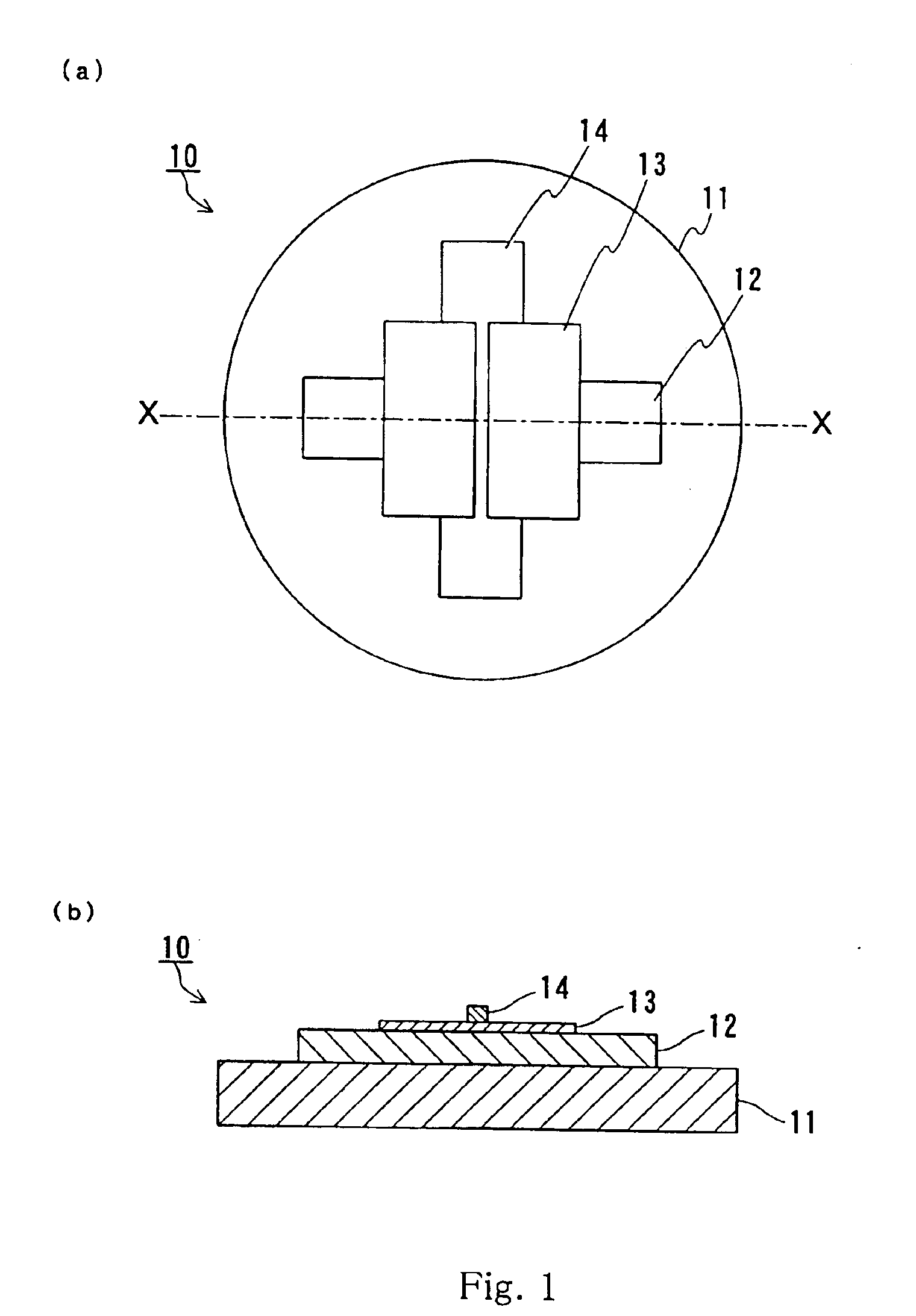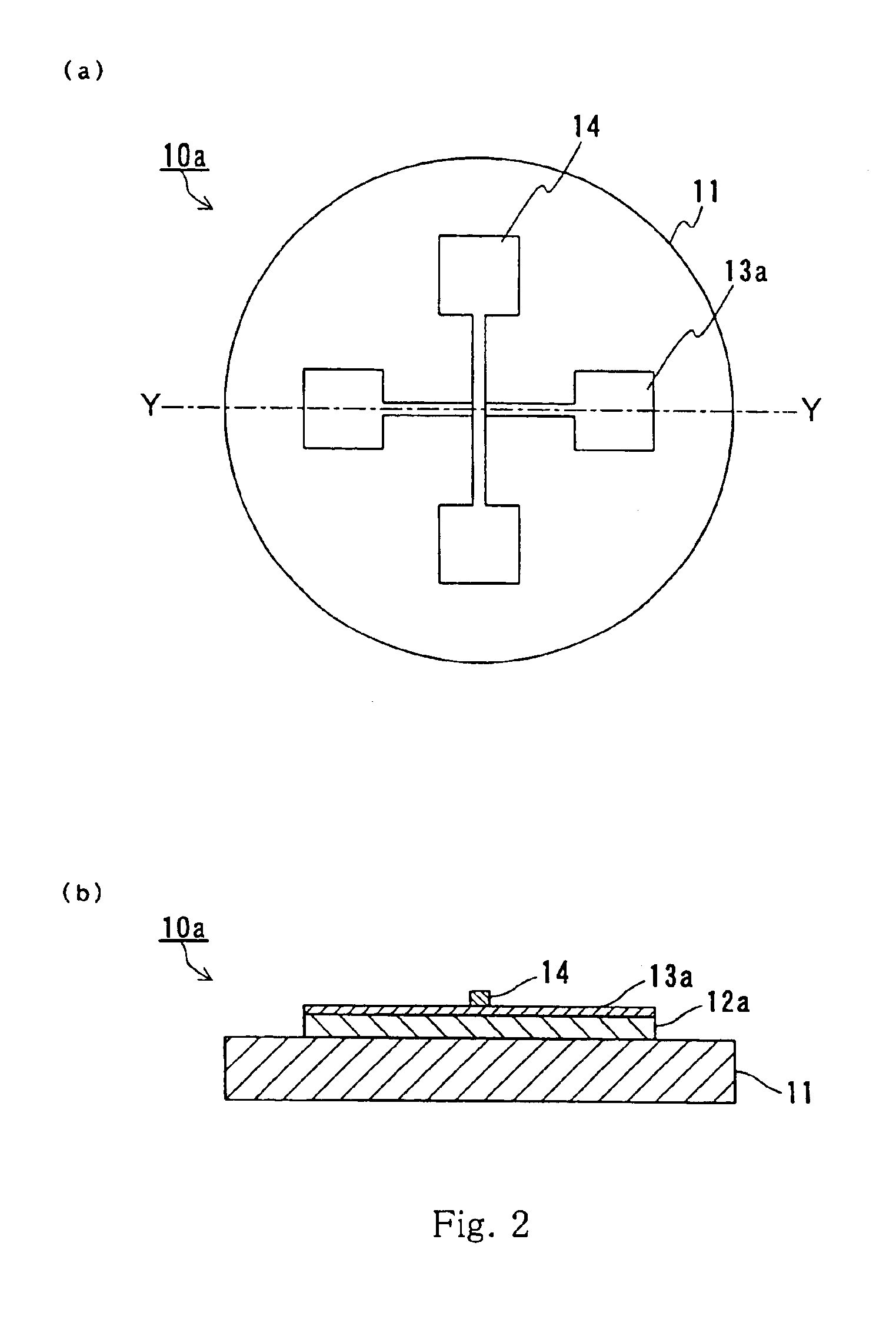Magnetoresistive device and method for producing the same, and magnetic component
a magnetoresistive device and magnetic component technology, applied in the direction of magnetic bodies, transportation and packaging, substrate/intermediate layers, etc., can solve the problems of insufficient thermal stability of conventional mr devices, high mr (magneto resistance) not being realized, and the oxidation of the lower ferromagnetic film beyond the aluminum film, etc., to achieve easy control, shorten the time for forming the high-resistivity layer, and increase the diffusion velocity of elemen
- Summary
- Abstract
- Description
- Claims
- Application Information
AI Technical Summary
Benefits of technology
Problems solved by technology
Method used
Image
Examples
first embodiment
[0060]In the first embodiment, an example of a magnetoresistive device of the present invention is described.
[0061]FIG. 1(a) shows a plan view of a magnetoresistive device 10 of a first embodiment. FIG. 1(b) shows a sectional view taken along the line X—X of FIG. 1(a).
[0062]Referring to FIG. 1, a magnetoresistive device 10 includes a substrate 11, and a first magnetic layer 12, a high-resistivity layer 13 and a second magnetic layer 14 laminated one by one on the substrate 11. In other words, the magnetoresistive device 10 includes the high-resistivity layer 13, and the first magnetic layer 12 and the second magnetic layer 14 arranged so as to sandwich the high-resistivity layer 13.
[0063]Various substrates may be used for the substrate 11. Specifically, for example, a single crystal (magnesia, sapphire, STO, etc.), polycrystal (e.g. AITIC substrate), amorphous (thermal oxide film of silicon), or conductive substrate (or an oxide of alumina or silicon formed on a base) may be employe...
second embodiment
[0080]In the second embodiment, an example of the method for producing a magnetoresistive device according to the present invention is described. With respect to the same parts and elements as those described in the first embodiment, the same numerals are applied, and overlapped explanations thereof are omitted.
[0081]The method of the second embodiment includes:
[0082](a) forming a first magnetic layer 12a located on a substrate 11, and a high-resistivity layer 13 located on the first magnetic layer 12a and containing at least one element LONC selected from oxygen, nitrogen and carbon; and
[0083](b) forming a second magnetic layer 14 on the high-resistivity layer 13. The first magnetic layer 12a contains at least one metal element M selected from Fe, Ni and Co, and contains an element RCP different from the metal element M. As described in the first embodiment, the element RCP combines with the element LONC more easily in terms of energy than the metal element M. It is preferable that...
third embodiment
[0108]In the third embodiment, a magnetic component of the present invention is described.
[0109]The magnetic component of the present invention includes a magnetoresistive device. The magnetoresistive device is obtained by heating the magnetoresistive device of the present invention described in the first embodiment at a temperature of at least 200 C.
PUM
| Property | Measurement | Unit |
|---|---|---|
| temperature | aaaaa | aaaaa |
| temperature | aaaaa | aaaaa |
| thickness | aaaaa | aaaaa |
Abstract
Description
Claims
Application Information
 Login to View More
Login to View More - R&D
- Intellectual Property
- Life Sciences
- Materials
- Tech Scout
- Unparalleled Data Quality
- Higher Quality Content
- 60% Fewer Hallucinations
Browse by: Latest US Patents, China's latest patents, Technical Efficacy Thesaurus, Application Domain, Technology Topic, Popular Technical Reports.
© 2025 PatSnap. All rights reserved.Legal|Privacy policy|Modern Slavery Act Transparency Statement|Sitemap|About US| Contact US: help@patsnap.com



